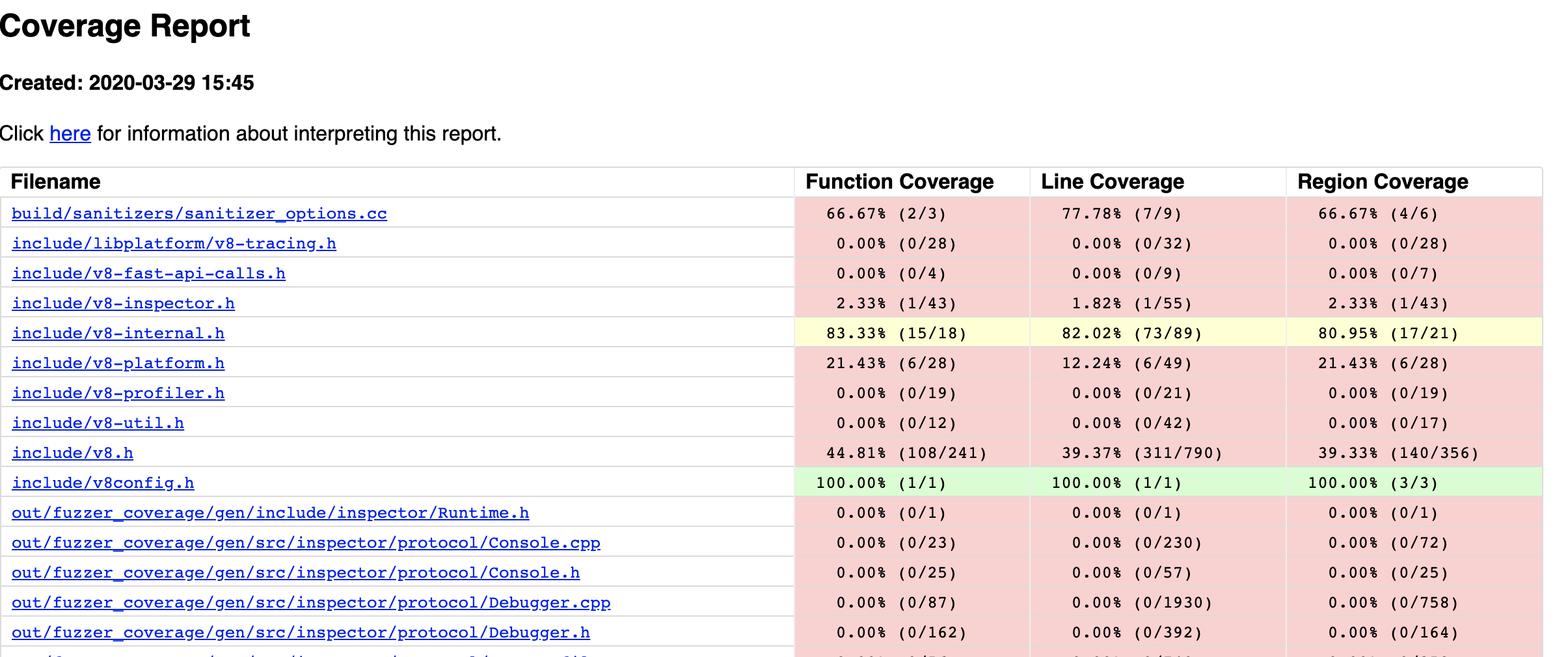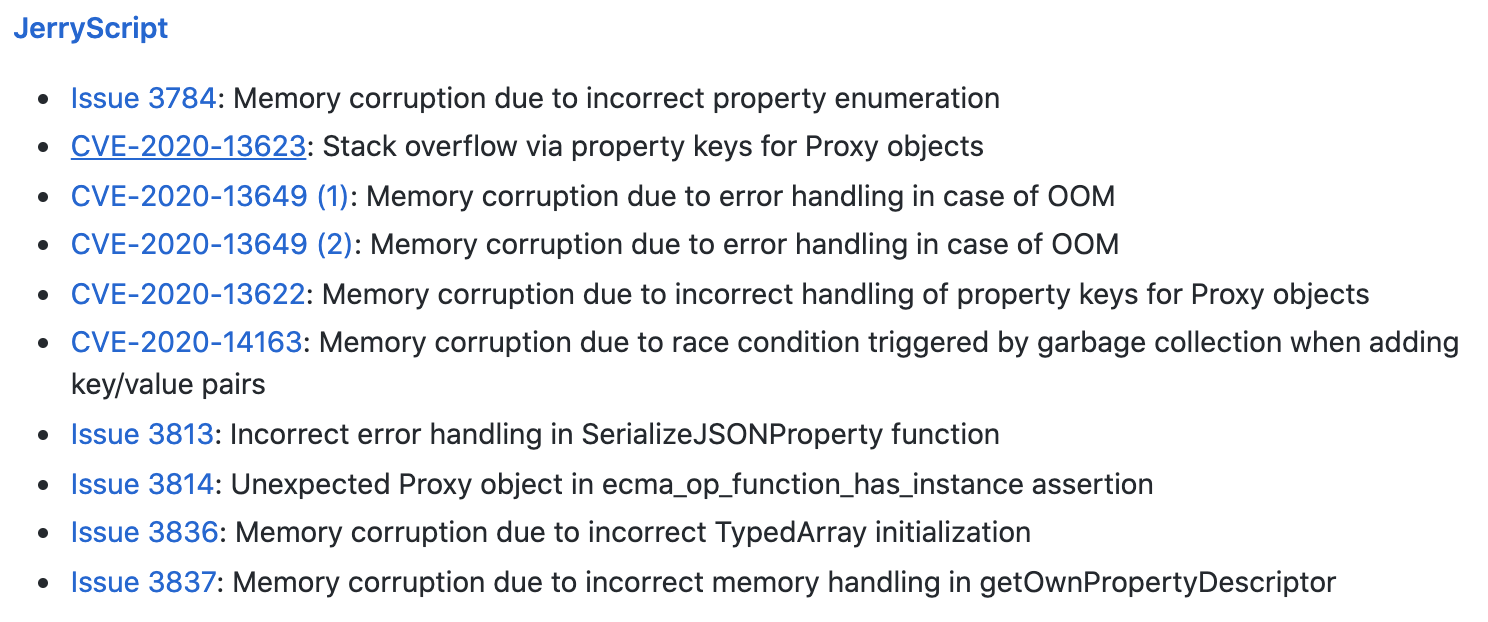Fuzzing JavaScript Engines with Fuzzilli
09 Sep 2020 - Posted by Norbert SzeteiBackground
As part of my research at Doyensec, I spent some time trying to understand current fuzzing techniques, which could be leveraged against the popular JavaScript engines (JSE) with a focus on V8. Note that I did not have any prior experience with fuzzing JSEs before starting this journey.
Dharma
My experimentation started with a context-free grammar (CFG) generator: Dharma. I quickly realized that the grammar rules for generating valid JavaScript code that does something interesting are too complicated. Type confusion and JIT engine bugs were my primary focus, however, most of the generated code was syntactically incorrect. Every statement was wrapped in a try/catch block to deal with the incorrect code. After a few days of fuzzing, I was only able to find out-of-memory (OOM) bugs. If you want to read more about V8 JIT and Dharma, I recommend this thoughtful research.
Dharma allows you to specify three sections for various purposes. The first one is called variable and enables you the definition of variables later used in the value section. The last one, variance is commonly used to specify the starting symbol for expanding the CFG tree.
The linkage is implemented inside the value and a nice feature of Dharma is that here you only define the assignment rules or function invocations, and the variables are automatically created when needed. However, if we assign a variable of type A to one with the different type B, we have to include all the type A rules inside the type B object.
Here is an example of such rule:
try { !TYPEDARRAY! = !ARRAYBUFFER!.slice(!ANY_FUNCTION!, !ANY_FUNCTION!) } catch (e) {};
As you can imagine, without writing an additional library, the code quickly becomes complicated and clumsy.
Fuzzing with coverage is mandatory when targeting popular software as a pure blackbox approach only scratches the attack surface. Coverage could be easily obtained when the binary is compiled with a specific Clang (compiler frontend, part of the LLVM infrastructure) flag. Part of the output could be seen in the picture below. In my case, it was only useful for the manual code review and grammar adjustment, as there was no convenient way how to implement the mutator on the JavaScript source code.

Fuzzilli
As an alternative approach, I started to play with Fuzzilli, which I think is incredible and still a very underrated fuzzer, implemented by Samuel Groß (aka Saelo). Fuzzilli uses an intermediate representation (IR) language called FuzzIL, which is perfectly suitable for mutating. Moreover, any program in FuzzIL could always be converted (lifted) to a valid JavaScript code.
At that time, the supported targets were V8, SpiderMonkey, and JavaScriptCore. As these engines continuously undergo widespread fuzzing, I instead decided to implement support for a different JavaScript Engine. I was also interested in the communication protocol between the fuzzer and the engine, so I considered expanding this fuzzer to be an excellent exercise.
I decided to add support for JerryScript. In the past years, numerous security issues have been discovered on this target by Fuzzinator, which uses the ANTLR v4 testcase generator Grammarinator. Those bugs were investigated and fixed, so I wanted to see if Fuzzilli could find something new.
Fuzzilli Basics
REPRL
The best available high-level documentation about Fuzzilli is Samuel’s Masters Thesis, where it was introduced, and I strongly recommend reading it as this article summarizes some of the novel ideas.
Many modern fuzzer architectures use Forkserver. The idea behind it is to run the program until the initialization is complete, but before it processes any input. Right after that, the input from the fuzzer is read and passed to a newly forked child. The overhead is low since the initialization possibly only occurs once, or when a restart is needed (e.g. in the case of continuous memory leaks).
Fuzzilli uses the REPRL approach, which saves the overhead caused by fork() and the measured execution per sample could be ~7 times faster. The JSE engine is modified to read the input from the fuzzer, and after it executes the sample, it obtains the coverage. The crucial part is to reset the state, which is normally (obviously) not done, as the engine uses the context of the already defined variables. In contrast with the Forkserver, we need a rudimentary knowledge of the engine. It is useful to know how the engine’s string representation is internally implemented to feed the input or add additional commands.
Coverage
LLVM gives a convenient way to obtain the edge coverage. Providing the -fsanitize-coverage=trace-pc-guard compiler flag to Clang, we can receive a pointer to the start and end of the regions, which are initialized by the guard number, as can be read in the llvm documentation:
extern "C" void __sanitizer_cov_trace_pc_guard_init(uint32_t *start,
uint32_t *stop) {
static uint64_t N; // Counter for the guards.
if (start == stop || *start) return; // Initialize only once.
printf("INIT: %p %p\n", start, stop);
for (uint32_t *x = start; x < stop; x++)
*x = ++N; // Guards should start from 1.
}
The guard regions are included in the JSE target. This means that the JavaScript engine must be modified to accommodate these changes. Whenever a branch is executed, the __sanitizer_cov_trace_pc_guard callback is called. Fuzzilli uses a POSIX shared memory object (shmem) to avoid the overhead when passing the data to the parent process. Shmem represents a bitmap, where the visited edge is set and, after each JavaScript input pass, the edge guards are reinitialized.
Generation
We are not going to repeat the program generation algorithms, as they are closely described in the thesis. The surprising fact is that all the programs stem from this simple JavaScript by cleverly applying multiple mutators:
Object()
Integration with JerryScript
To add a new target, several modifications for Fuzzilli should be implemented. From a high level, the REPRL pseudocode is described here.
As we already mentioned, the JavaScript engine must be modified to conform to Fuzzilli’s protocol. To keep the same code standards and logic, we recommend adding a custom command line parameter to the engine. If we decide to run the interpreter without it, it will run normally. Otherwise, it uses the hardcoded descriptor numbers to make the parent knows that the interpreter is ready to process our input.
Fuzzilli internally uses a custom command, by default called fuzzilli, which the interpreter should also implement. The first parameter represents the operator - it could be FUZZILLI_CRASH or FUZZILLI_PRINT. The former is used to check if we can intercept the segmentation faults, while the latter (optional) is used to print the output passed as an argument. By design, the fuzzer prevents execution when some checks fail, e.g., the operation FUZZILLI_CRASH is not implemented.
The code is very similar between different targets, as you can see in the patch for JerryScript that we submitted.
For a basic setup, one needs to write a short profile file stored in Sources/FuzzilliCli/Profiles/. Here we can specify additional builtins specific to the engine, arguments, or thanks to the recent contribution from WilliamParks also the ECMAScriptVersion.
Results
By integrating Fuzzilli with JerryScript, Doyensec was able to identify multiple bugs reported over the course of four weeks through GitHub. All of these issues were fixed.
All issues were also added to the Fuzzilli Bug Showcase:

Fuzzilli is by design efficient against targets with JIT compilers. It can abuse the non-linear execution flow by generating nested callbacks, Prototypes or Proxy objects, where the state of a different object could be modified. Samples produced by Fuzzilli are specifically generated to incorporate these properties, as required for the discovery of type confusion bugs.
This behavior could be easily seen in the Issue #3836. As in most cases, the proof of concept generated by Fuzzilli is very simple:
function main() {
var v3 = new Float64Array(6);
var v4 = v3.buffer;
v4.constructor = Uint8Array;
var v5 = new Float64Array(v3);
}
main();
This could be rewritten without changing the semantics to an even simpler code:
var v1 = new Float64Array(6);
v1.buffer.constructor = Uint8Array;
new Float64Array(v1);
The root cause of this issue is described in the fix.
In JavaScript when a typed array like Float64Array is created, a raw binary data buffer could be accessed via the buffer property, represented by the ArrayBuffer type. However, the type was later altered to typed array view Uint8Array. During the initialization, the engine was expecting an ArrayBuffer instead of the typed array. When calling the ecma_arraybuffer_get_buffer function, the typed array pointer was cast to ArrayBuffer. Note that this is possible since the production build’s asserts are removed. This caused the type confusion bug on line 196.
Consequently, the destination buffer dst_buf_p contained an incorrect pointer, as we can see the memory corruption from the triage via gdb:
Program received signal SIGSEGV, Segmentation fault.
ecma_typedarray_create_object_with_typedarray (typedarray_id=ECMA_FLOAT64_ARRAY, element_size_shift=<optimized out>, proto_p=<optimized out>, typedarray_p=0x5555556bd408 <jerry_global_heap+480>)
at /home/jerryscript/jerry-core/ecma/operations/ecma-typedarray-object.c:655
655 memcpy (dst_buf_p, src_buf_p, array_length << element_size_shift);
(gdb) x/i $rip
=> 0x55555557654e <ecma_op_create_typedarray+346>: rep movsb %ds:(%rsi),%es:(%rdi)
(gdb) i r rdi
rdi 0x3004100020008 844704103137288
Some of the issues, including the one mentioned above, could be probably escalated from Denial of Service to Code Execution. Because of the time constraints and little added value, we have not tried to implement a working exploit.
I want to thank Saelo for including my JerryScript patch into Fuzzilli. And many thanks to Doyensec for the funded 25% research time, which made this project possible.

